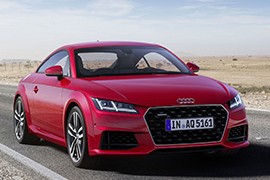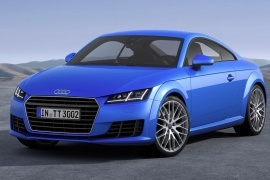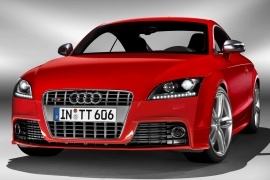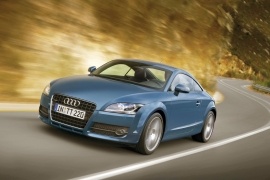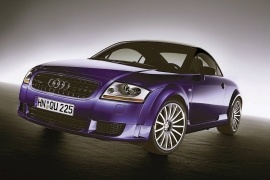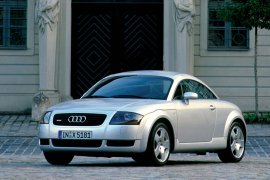AUDI TT Coupe Models/Series Timeline, Specifications & Photos
First production year: 1998
Engines: Gasoline, Diesel
Body style: Coupé (two-door)
In late 2020, Audi unveiled a new version of its acclaimed compact coupe, the TTS.
Since its introduction in 1998, Audi TT was one of the most praised cars from the German carmaker lineup. Its shapes, initially designed by Peter Schreyer, looked like no other compact coupe on the market. The evolution followed, and in 2020 the car reached its third generation, which was launched in 2014. Despite a world pandemic situation, Audi pushed harder and introduced the Competition Plus for the TTS range.
The German carmaker installed standard LED headlights and a black Audi rings at the front. A black splitter was placed at the bottom of the apron. From its sides, the TTS Competition Plus showed the standard 20" light-alloy 10-spoke wheels and, behind them, a set of red-painted brake calipers. In the rear, a fixed-wing on the trunk amplified the car's sportiness. Under the car, separated by a glossy black diffuser, the carmaker placed the four oval exhausts.
Inside, the driver stood in front of a 12.3 virtual cockpit that replaced the analog dials as a standard feature of the car. The Nappa leather with red or blue contrast stitching enhanced the interior's look. The attention to detail was great, and the designers decided to add a stitched 12 o'clock marker red or gray on the flat-bottom steering wheel.
The TTS Competition Plus featured magnetic ride control for the suspension and a Quattro all-wheel-drive system. Power came from the 2.0-liter TFSI engine pushed to provide 320 hp via a 7-speed S-Tronic gearbox (dual-clutch).
Twenty years after the original Audi TT came on the market, and the compact-coupe still looks fresh and strong. In 2018, Audi introduced the TTS stronger and faster than before. The exterior has been changed discretely and brought a new three-dimensional Singleframe radiator grille design and larger side air inlets.
The TTS Black edition received further upgrades with a new full-length front splitter flanked by vertical inlets, exclusive side sills with inserts and, at the rear, vertical air inlets with horizontal fins below the rear lights and a different diffuser.
Inside, the driver has the Audi Virtual Cockpit, which featured an additional sport display, providing information on engine output, torque and g forces. Inside the air-vents from the central part of the dashboard, the designers installed displays for temperature, air-flow, and fan speed. A nice space-saving method.
But usually, those who are buying a performance coupe are more interested in the numbers. Even though the TTS lost 4 hp compared to the non-facelift version and the 2018 model had 306 hp. It gained a little in the 0-100 kph (0-62 mph) sprint. This is maybe because it gained a little bit of torque or due to the standard 7-speed DSG (dual-clutch) automatic gearbox.
The TTS featured the quattro all-wheel drive system from Audi and it had a lowered suspension by 10 mm (0.4”) compared to the rest of the TT range. It also featured the Audi magnetic ride adaptive damper control,
Twenty years after the original Audi TT came on the market, and the compact-coupe still looks fresh and strong. In 2018, Audi introduced a facelift for the third generation.
The exterior has been changed discretely and brought a new three-dimensional Singleframe radiator grille design and larger side air inlets. The new, optional, S line exterior package underscored the sporty character of the car. It included a full-length front splitter, a radiator grille in titanium black, and specific side sills with inserts as well as a sporty rear end. A wider diffuser was added to the back.
Inside, the driver had the Audi Virtual Cockpit, which featured an additional sport display, providing information on engine output, torque and g forces. Inside the air-vents from the central part of the dashboard, the designers installed displays for temperature, air-flow, and fan speed. A nice space-saving method. The infotainment system, named MMI, was simplified and it featured just six key-buttons on the center console, between the front seats. It integrated a touch-pad on top of the rotary knob. As before, the TT was fitted with four seats, but only those in the front were offered enough room to be used.
The 2018 model was fitted with the same 2.0-liter turbocharged engine and more power choices. It was mated with either a 6-speed manual or a 7-speed DSG (dual-clutch). A special version, TTS, was offered with a 2.5-liter unit.
The third-generation Audi TT debuted at the 2014 Geneva Motor Show, following the ingredients of the iconic first version while adding more dramatic styling, innovative technologies, and new functions.
Both previous models of the Audi TT coupe have stood out for their very stylish design, sporty performance, and weather-beating all-wheel drive. For years Audi tried to keep that exotic air for their TTs.
Horizontal lines dominate the front of the new TT. The Singleframe grille is much broader and flatter than the previous model, with a powerful line dividing it into two zones. The top corners of the grille, sharp contours run in a V across the hood, bearing the four Audi rings.
The flat headlights give the new TT's face a determined look, while the new TT looks equally lean and muscular from the side. The flat greenhouse gives the impression of an independent unit, and the slight kink in the rear side window gives it additional tension, while the rear tries to mirror the front end with horizontal lines and flat taillamps.
Lightweight construction is one of Audi's greatest areas of expertise, and the coupe's underbody structure has optimized axle loads, and high-strength steel panels. At the same time, the side sills and roof frame are made of extruded aluminum profiles. This little beauty won't be mistaken for anything else on the road.
The interior designs also score points for their well-built and high quality. Clear, purist lines underscore the lightness and the uncompromising sportiness of the Audi TT's interior. The new multifunction steering wheel has a flattened rim, and aluminum-look clasps encompass the spokes. At the same time, countless other details demonstrate the high standards which Audi places on interior design and craftsmanship.
All cars come with DAB radio, leather seats, and climate control, and one of the most interesting things is Audi's superb Virtual Cockpit system, a 12.3-inch high-resolution LCD. On the screen, many features are available, and anything you need to know is right in front of you.
Audi safety standards are among the best on the market, with features including traction and stability control, antilock disc brakes, hill-hold assist, front-side airbags, and front knee airbags.
Performance is sufficient but not overwhelming, and AWD provides extra grip performance. Under the hood, the base TT fields a 211-horsepower four-cylinder engine and a six-speed automated manual transmission.
The high-performance petrolheads will have to do some research on the TT's rivals. Within its price range, the TT has some problems compared to the quicker and sharper Nissan 370Z, the muscular V8-powered Chevy Camaro, or even the Ford Mustang.
These cars are more refined, premium-looking, and classy than the TT. On the other hand, if you want a little bit of power combined with style, the 2014 Audi TT should be a satisfying choice.
The third generation of the Audi TT was introduced at the 2014 Geneva Motor Show. And the car-manufacturer didn't let the enthusiasts wait and it announced the TTS version as well.
From the first look, a TTS version stands out from its other siblings due to its silver rear-view mirrors casings, and large single-frame grille with horizontal chrome bars. The side scoops in front of the wheels were needed to improve the brake cooling.
Inside the car, two bucket-seats could hold its occupants better when hard cornering. Likewise the TT, the rear seats were just for tax and insurance purposes. At least, the manufacturer installed a label regarding the maximum height of the rear passengers.
The TTS not only had a 54 more hp than the regular gasoline TT but also featured some other amenities to go well with its performances. The TTS had its body lowered ten millimeters (0.4 in). The TTS came standard with 18-inch wheels and 245/40 tires. Wheels sizes up to 20 inches were available as options. The vented front brake discs measured 338 millimeters (12.3 and 13.3 in) in diameter. The TTS is equipped up front with newly developed, particularly lightweight aluminum fixed-caliper brakes. The standard gearbox was a 6-speed dual-clutch for the all-wheel-drive (quattro) system.
The Audi TT Coupe TTS was launched at the 2008 North American International Auto Show and it was the sportier version of the already sporty coupe TT.
The second generation of the Audi TT was well received all around the world due to its compact size, attractive look, and its performances. It didn't have any outstanding design cues as other coupes of its size, but it did have its appeal.
The TTS version was easy to recognize due to its lip-spoiler painted in body color, a metallic-grey grille, and a rear diffuser that was not present on the TT model. The quad-oval exhausts in the rear were typical for the S-versions of the Audi models and it was installed in the little coupe. Though it was uncommon to see four pipes on a four-cylinder car.
Inside the car, there was seating for four, with ample front bucket-seats. In the rear, there was no real room for adults, or for anyone that needed more than a couple of inches of legroom. The headroom was so small, that the designers didn't even fit a pair of headrests. Or maybe they knew that nobody will ever seat there. The dashboard featured five air vents, with three in the middle, above the infotainment unit.
Under the hood, there was a revised version of the four-cylinder 2.0-TFSI engine of the other TT versions. Most importantly, it featured adaptive sport suspension to keep the car better planted on the road than the non-S version. There were two gearbox options: a 6-speed manual and a 7-speed, dual-clutch, automatic. It featured a standard all-wheel-drive traction system.
The second-generation Audi TT model was assembled on a platform featuring a combination of aluminum and steel components. After the radical styling of the original Audi TT, this second generation, or the Mk2, might look more sporty and stylish.
As said before, most of the car's chassis and bodywork is aluminum (69 to 31 percent, respectively), making it lighter than the previous model. The Mk2 TT it's bigger and has slightly more room inside. This weight loss gives the TT amazing agility, and, combined with the perky engine options, it's very fast in a straight line and grippy around the corners.
The interior tends to premium car design. Aluminum and leather are dominant inside the cabin design blending retro and modern elements into one alluring package. A standard power glass wind blocker ensures that chilly nights along the beach are pleasant for roadster owners. The trunk capacity is 13.8 cubes in front-drive coupes, which is not very much, but it might be enough if we think it is more of a two-person car.
Gone was the common 1.8 turbo petrol engine from the Mk1, and came with the 2.0L turbocharged TFSI engine delivering 200 hp or a 250-hp naturally aspired 3.2L V6, both equipped with a standard 6-speed manual transmission or the optional S-tronic dual-clutch gearbox. The more popular 2.0 TFSI unit, also found on the contemporary Volkswagen Golf GTI, managed 0-60mph in just 6.4 seconds.
The first unit came with a front-wheel-drive, while the V6 was available with a standard all-wheel-drive, the well-known QUATTRO. Other new features on the Audi TT Coupe include a redesigned sport-oriented suspension, a larger track (due to the introduction of wider wheels), and an optional high-tech Audi magnetic ride damper system.
Audi's new active suspension, called Audi Magnetic Ride, is based on BWI Group's technology, which uses magnetorheological dampers, meaning that an electronic control unit for the suspension will automatically adjust damping properties depending on the road conditions and driving style.
In 2008, Audi challenged the sport-compact coupe segment by introducing the 2.0 TDI engine in the TT, delivering a power of 170 hp and 350 Nm (258 lb.-ft) of torque. It was available only in an all-wheel-drive Quattro version.
In 2010 Audi showed up a facelift of the 2006 model. The LED daytime running lights became standard for S-Line models, while the 2.0 TFSI was given a power boost to achieve 212hp. An optional 'Sport' button for all non-RS models was also added at that time.
The 2006 and the 2010 TT models come with four-wheel antilock disc brakes and electronic stability control. Side and head airbags are standard, and Audi contends that the protection level of the roadster in a rollover is equal to that of the sports coupe. In government side-impact crash testing, the 2006 Audi TT received a perfect five stars for the protection of front occupants.
Owners are generally satisfied with their cars, and there are few reported faults. The TT of this generation seems to be bulletproof so far. Reported problems are few, although it should be noted that the previous model got a below-average overall score for reliability.
The TT may disappoint if you seek the ultimate performance sports coupe or roadster. But if you're willing to give up a little performance and get a stylish coupe, the 2006 Audi TT still remains a head-turner after all these years.
AUDI TT Coupe 1.8L TFSI 6MT FWD (160 HP)
AUDI TT Coupe 1.8L TFSI 7AT FWD (160 HP)
AUDI TT Coupe 2.0L TFSI 6AT FWD (211 HP)
AUDI TT Coupe 2.0L TFSI 6MT FWD (211 HP)
AUDI TT Coupe 2.0L TFSI FWD (200 HP)
AUDI TT Coupe 2.0L TFSI Quattro 6AT AWD (211 HP)
Audi introduced in 2005 a special edition for its compact coupe sports car, the TT Quattro Sport. It was a celebration for 25 years of quattro all-wheel-drive system.
Audi was not the first car manufacturer to enter the market with an all-wheel-drive vehicle. Subaru and Jensen Interceptor FF did that before them. But Audi was the one who made the all-wheel-drive revolution happened when it won the World Rally Championship with the Audi Quattro. Its victories proved that the system was a better choice than the front-wheel-drive or rear-wheel-drive vehicles. To celebrate the Quattro victories and the introduction of that system on the market, Audi prepared a special version based on the TT. It was named Quattro sport.
The Quattro sport was basically a lighter Audi TT with a two-tone paint job and a more powerful engine. The bodywork was a carry-over from the much powerful TT 3.2-liter V6 version, with flared wheel arches. The 15-spoke 18” light-alloy wheels were specially designed for the limited series model. The roof, the rearview mirrors and the small spoiler on the trunk-lid were painted in black
Inside, the car featured two sport-bucket seats with racing inspiration. The rear seats and the parcel-shelf were removed. The Audi engineers shaved about 50 kg (110 lbs) from the normal vehicle. But they didn't stop there.
Under the hood, there was the same 1.8-liter bi-turbo engine from its siblings but tuned to deliver 15 hp more. A stiffened suspension and a wider track made the car more planted to the road and faster than its more powerful sibling, the 3.2-liter version.
In 1995, at the Frankfurt Motor Show, Audi showed the concept of a future coupe with two seats, an all-wheel-drive and a bold look. The concept-car was very well received by the market and Audi decided to make it a series model.
Three years after the concept-car was revealed, the series Audi TT was launched on the market. This time, the world was shocked since the series version looked almost the same as the concept car. The car was based on a shortened platform of the Audi A3/VW Golf V. Its rounded forms, with a short cabin and sloped back was very well received by the market. It even had seats in the back, which could have been folded to expand the small trunk.
Inside, the instrument cluster was exactly the same as the concept vehicle. There were two bigger analog dials and two smaller ones, for speedometer, tachometer, fuel level, and engine temperature. Between the two big dials, there was the screen for the on-board computer. The bucket seats were meant to keep its occupants in place, while hard-cornering. And the car had a good appetite for corners. As for the rear seats, the manufacturer placed a stick memo just a reminder that passengers under 1.65m tall are allowed.
At the launch, the TT had one engine option with two power outputs: a 1.8-liter engine with 5 valves per cylinder that offer 180 hp and 225 hp, respectively. The latter was available only with the all-wheel-drive system. In 2003, a VR6, 3.2-liter engine was added.


